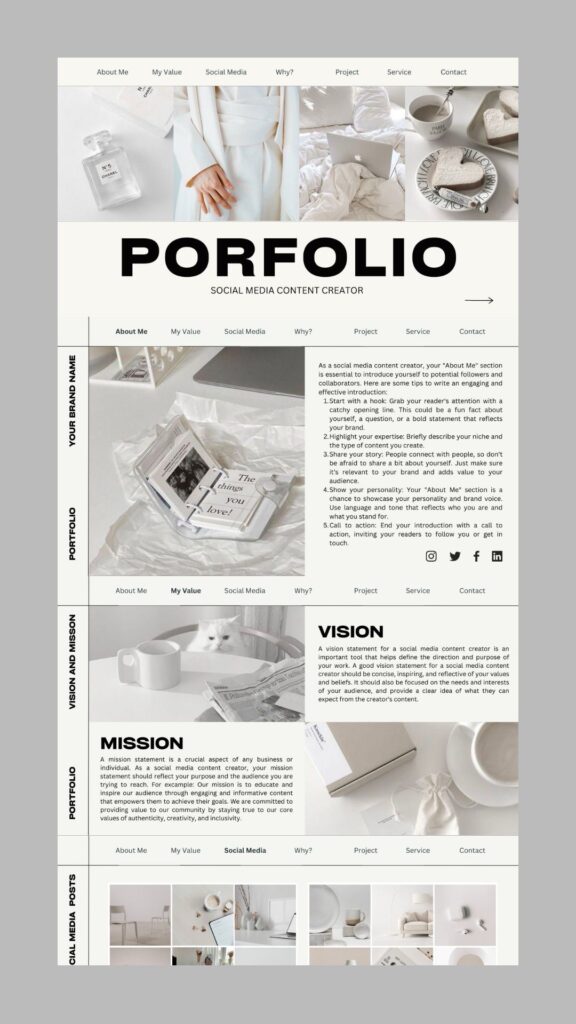Your cart is currently empty!
One of the biggest lies new freelance writers are told is that you need to “get experience first” before you can create a portfolio. That mindset keeps too many talented people stuck waiting for someone to give them permission to begin. The truth is you can build a freelance writing portfolio without clients. In fact, some of the strongest portfolios I’ve seen were built before the writer ever got paid.
If you’re just starting out, your portfolio doesn’t need to be packed with big-name bylines or agency work. What it does need is clarity, relevance, and examples of your writing style. Whether you’re niching into tech, lifestyle, wellness, finance, or storytelling, your writing samples can show your value before your resume does.
In this post, I’ll walk you through exactly how to build a freelance writing portfolio without clients. You’ll learn what makes a good portfolio, the five easiest ways to start from scratch, and how to package it so it looks professional, even if you’re just getting started.
Want to skip the trial and error?
Download the Free Freelance Setup Checklist to organize your writing business with systems that make you look experienced from day one.


What Makes a Strong Freelance Writing Portfolio?
Before we dive into the “how,” let’s cover the “what.” When you’re creating a freelance writing portfolio without clients, it’s easy to overthink. But the truth is clients aren’t looking for perfection. They’re looking for proof that you understand their audience, their tone, and how to communicate ideas clearly.
Here’s what makes a strong portfolio stand out, even if you’ve never been hired:
Relevance to the niche
If you want to work with finance brands, don’t fill your portfolio with food blog-style writing. Even without real projects, your samples should match the type of clients you want to attract.
Writing clarity
Clients want to see that you can explain ideas in simple, engaging language. No filler. Just clean writing with good structure.
Consistent tone and formatting
Even if you’re using different platforms (Medium, Google Docs, Notion), keep your samples formatted similarly. Headings, spacing, fonts, all of that affects readability.
A clear purpose behind every piece
Each sample should show something different: storytelling skills, SEO structure, instructional writing, or brand voice alignment. You’re not just proving you can write, you’re showing that you can write for them.
Want a full system for pitching, pricing, and sending proposals?
Check out the Make Your First ₦100K as a Freelancer eBook. It’s designed to help beginner writers look like pros and get paid like it too. And it is FREE.
5 Ways to Build a Freelance Writing Portfolio Without Clients
Now let’s get into the part that matters most: how to build a writing portfolio from scratch, even if you don’t have a single paid project under your belt.
These five methods are tested, beginner-friendly, and will give you samples you can start sharing this week.
1. Write for Yourself on Medium, Substack, or Your Own Blog
Medium and Substack are two of the easiest places to publish your writing professionally, without needing a website or permission from anyone.
Choose a niche you’d like to write in (e.g., self-development, tech, marketing), then write a high-quality piece that solves a problem, teaches something, or shares a unique perspective. Treat it like real client work.
If you already have a blog, optimize those posts and use them as portfolio samples.
Keyword tip: Include relevant headers and keywords in each article to show clients that you understand content structure, a major green flag for anyone hiring a writer.
2. Create Sample Projects for Your Dream Clients
Pick three brands, businesses, or blogs you’d love to write for. Then, pretend they’ve already hired you. Create a mock blog post, email newsletter, or landing page copy, whatever fits their style.
This is one of the most underrated ways to build a freelance writing portfolio without clients. It shows initiative, research, and alignment with their tone, all without crossing into plagiarism.
Just make it clear that the piece is a self-initiated sample. Add a simple line like:
“Spec piece created for portfolio purposes, inspired by [Brand Name].”
Pro tip: Pick brands that exist but don’t already have great content. It’s easier to stand out when there’s room for improvement.
3. Rewrite Existing Brand Content as a “What I’d Do Instead” Piece
This one takes guts but works beautifully when done right.
Find a blog post, product page, or newsletter from a small business and rewrite it in your own voice with improved flow, stronger structure, or a clearer CTA.
This works especially well if you’re targeting startups or solopreneurs who haven’t invested in professional content yet.
Format:
Original piece → “What’s not working” (a short paragraph) Your rewrite → formatted like a real project
Keyword reminder: This is another great way to demonstrate your ability to produce sample writing for freelancers who want to be hired for brand work.
4. Offer Guest Posts or One-Off Samples (Without Overcommitting)
If you want real world feedback, offer to write one guest article or blog post for a friend’s business, a nonprofit, or a niche blog. Keep it clear that it’s a one-time offer. This gives you a published piece and experience collaborating with someone, even if it’s unpaid.
Look for calls for guest writers in Facebook groups, Substack communities, or even podcasts that accept content.
Boundaries matter here: you’re not offering free labor forever. This is a calculated move to get published work and a testimonial if possible.
5. Repurpose Past Work (Even If It Wasn’t “Freelance”)
This is the part most beginners overlook. If you’ve ever written an essay, email series, caption thread, or journaled thoughts that could be framed into an article, you have a head start.
Look through:
University papers Personal essays LinkedIn posts or Twitter threads Instagram captions with storytelling Presentations you’ve written
With some tweaking, these can be turned into polished samples. Focus on structure, flow, and formatting. Package it with a proper title and context, and it becomes a real piece in your writing portfolio.
Reminder: You don’t need a full website to host all of this.
How to Package Your Writing Portfolio Professionally
Once you have a few solid writing samples, the next step is to package them in a way that looks professional and is easy to navigate. You don’t need a personal website to do this. What matters is that your freelance writing portfolio is clear, scannable, and built with your ideal client in mind.
Start with a short personal intro. One paragraph that shares who you are, what kind of writing you do, and the types of clients you’re best suited for. This isn’t a life story, it’s a positioning statement.
Next, list out your writing samples. Keep it clean. You can use a simple Notion page, a Google Doc with clickable links, or a PDF file. Each sample should have a title, a short sentence explaining what it is, and a working link if it’s published online. For mock projects, add a line clarifying that the piece was created for portfolio purposes.
If possible, format each sample using the same structure, consistent headings, font sizes, and spacing. This creates visual professionalism, even if your pieces vary in style. Don’t over-design; clarity always wins.
Finally, end with a short section labeled “About Me” or “Services Offered.” Let potential clients know what kind of projects you take on and how to contact you.
A clean freelance writing portfolio without clients can still position you as credible, reliable, and worth hiring. What matters most is how you present what you already have.

Where to Host Your Portfolio (Free and Easy Options)
You don’t need a paid website to showcase your work. Several free tools make it easy to build a portfolio, especially for new freelance writers. Each comes with its own pros and cons, depending on how tech savvy you are or how much control you want over the look and feel.
Google Drive is still one of the easiest ways to create and share your portfolio. You can use a single Google Doc to organize your samples and make it view only. Add a short intro at the top, link to each piece, and format it like a professional document.
Notion is another powerful option, especially if you want your portfolio to feel more interactive or branded. You can create a custom portfolio layout, embed samples, and even include testimonials or links to your resume.
Medium works well if you want to build your credibility and have searchable writing. Each post you publish becomes a sample, and you can create a “Series” or link multiple pieces in a pinned article as your main portfolio.
Other options include Substack (for newsletter-style samples), Contently (for a curated portfolio feel), or Canva (if you want to design a sleek PDF portfolio).
Regardless of the platform, the priority is this: your portfolio must be accessible, easy to navigate, and tailored to the type of work you want to get paid for.
Final Thoughts: You Don’t Need Clients to Prove You Can Write
It’s easy to get caught in the loop of waiting for permission. Waiting for a client to show up so you can prove you’re good enough. But some of the most successful freelance writers started with personal blogs, unpaid guest posts, and mock content.
The goal isn’t perfection, it’s proof. Your writing portfolio is a living document that evolves with you. And the faster you start creating and packaging your work, the faster you build the confidence and credibility that attracts paying clients.
If you’ve been putting this off because you don’t feel ready, this is your sign to start anyway. You already have what it takes. You just need a strategy and the right tools.
Download the free Freelance Setup Checklist to start building your business foundation. And if you’re ready to move from setup to sales, check out my Make Your First ₦100K as a Freelancer eBook for free. It’s all about creating systems that get you hired.




Leave a Reply